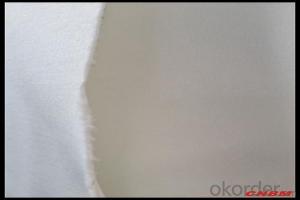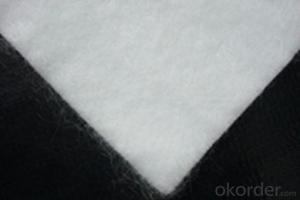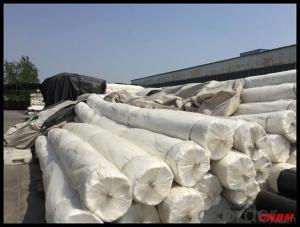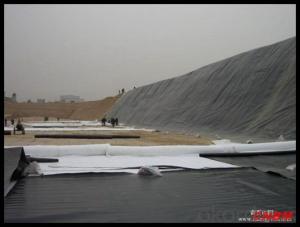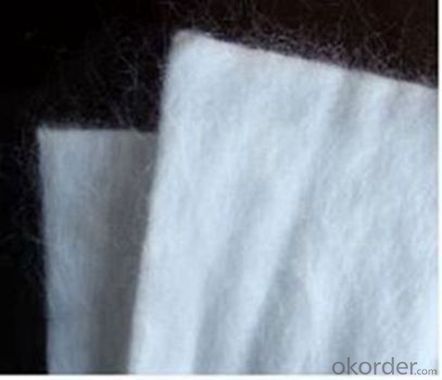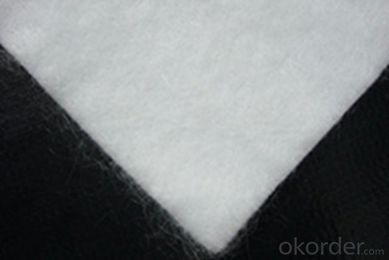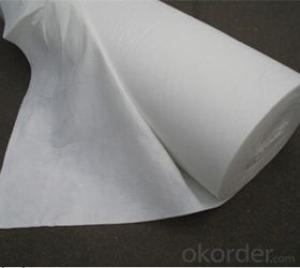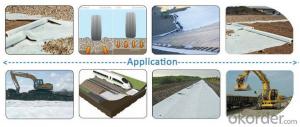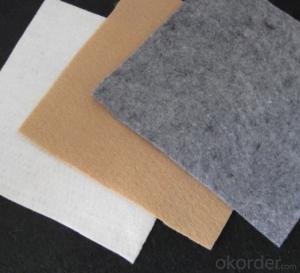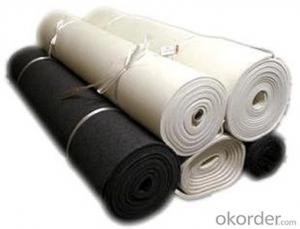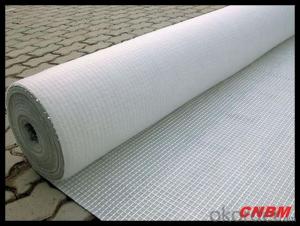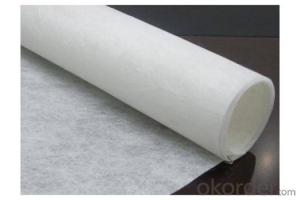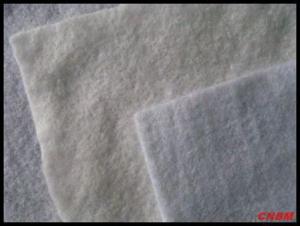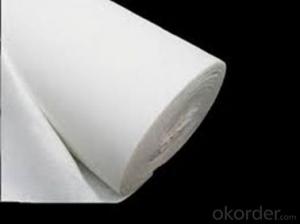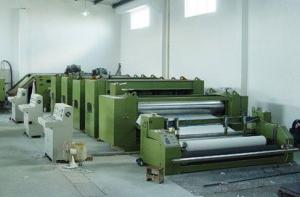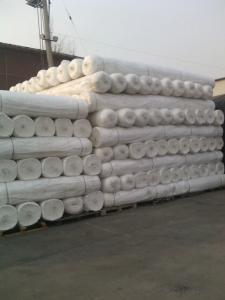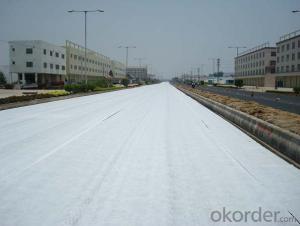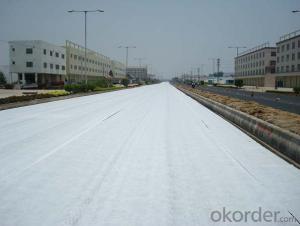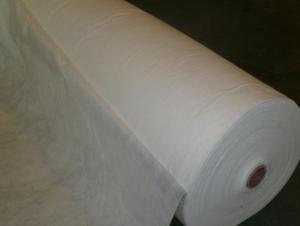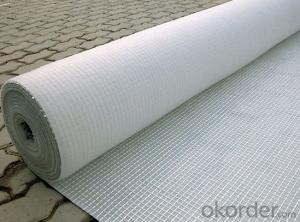Geotextile White Non-Woven Geotextile Fabric 300gsm for Railway-CNBM
- Loading Port:
- China main port
- Payment Terms:
- TT OR LC
- Min Order Qty:
- 5000 m²
- Supply Capability:
- 1000000 m²/month
OKorder Service Pledge
OKorder Financial Service
You Might Also Like
Specification
1.Isolation:
Use geotextile to isolate the mate rials(soil and sand,sand and gravel,soil and concrete.etc.)
with different physical properties (particle size,distribution,denseness and density.etc.);
To maintain the structure and function of them so that the load bearing capacity is strengthened.
2.Filtration:
To make advantage of the good air and water permeability of the needle-punched geotextiles to let
water flow through;
To cut off the soil grains,fine sands,small stones.etc.effectively to maintain the stability of the
water-soil engineering.
3.Drainage:
Geotextile is a great material for water diversion that it can form a drainage channel inside the soil
so that the extra liquid and gas inside the soil structure is discharged.
4.Reinforcement:
Making use of the geotextile’s strong pull resistance and deform resistance to the stability of the
buildings’ structure in order to increase the soil’s quality.
5.Protection:
Effectively spreading,delivering or resolving the concentrated stress to protect the soil from the
damage by external force.
6.Sealing:
The geotextile form impermeable layer inside the soil layer in conjunction with other materia
(primarily asphalt or plastic film)[mainly used for road,resurfacing,repairing.etc.
short fiber geotextile 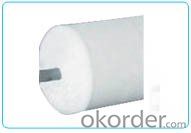
long fiber geotextile 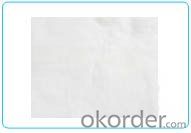
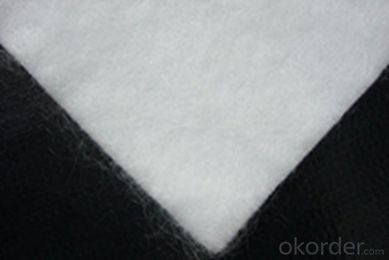
Quality assurance
1.On a regular basis or as per your request,we entrust national testing agencies to conduct quality inspections
2. Strictly in accordance with the ISO9001-2008 international quality system standard,we monitor and manage the whole process throughout production,quality testing,and measurement to ensure product quality
3. For quality-related construction delay or substandard construction(except for damage or losses due to customer’s responsibility or irresistible natural disasters),we have refunding,replacement,and repair services.We will respond to customers’ feedbacks on quality issues within 24 hours.
Packaging & Shipping
Packing: PLASTIC FILM INSIDE, AND WOVEN BAG OUTSIDE
Shipping: About 15 days after receipt the deposit
geotextile fabric
permeability,filtration,easy for construction
ISO and CE certificate
Good quality and competitive price
Our Service
FAQ:
Q: What kind of payments does jenor support?
A: T/T, L/C, Cash are accepted.
Q: Do you charge for the samples?
A: Accordeing to our company policy, the samples are free, we only charge the freight fee. And we will return the freight fee during the next order.
Q: Can you produce according to customers' design?
A: Sure, we are professional manufacturer, OEM and ODM are both welcome.
Q: Do you have other products?
A: Yes, please check the pictures:
- Q: Heap half a month later in the mound inside dug a tree tree hole, a heavy rain, a region which has two trees in the area of water, to several days of talent, which is normal, please expert advice, More
- Are you geotextile or composite film? Is your waterproofing layer ready? Do not leak?
- Q: How do geotextiles help in preventing soil erosion in vineyards?
- Geotextiles help prevent soil erosion in vineyards by acting as a protective layer. They are placed on the soil surface, acting as a barrier that prevents the topsoil from being washed away by rain or irrigation water. This helps maintain the integrity of the soil structure, retains moisture, and reduces the impact of wind erosion. Additionally, geotextiles promote better water infiltration and drainage, reducing the risk of runoff and soil erosion.
- Q: What are the different types of geotextile installation equipment?
- Some different types of geotextile installation equipment include geotextile rollers, geotextile spreaders, geotextile stitchers, and geotextile tensioners. These tools are used to properly position, secure, and connect geotextiles during installation for various applications such as erosion control, drainage, and reinforcement.
- Q: How do geotextiles contribute to groundwater recharge?
- Geotextiles contribute to groundwater recharge by providing a permeable barrier that allows water to infiltrate into the ground while retaining sediment and preventing erosion. This helps to replenish underground aquifers and maintain water levels, ultimately supporting the replenishment of groundwater resources.
- Q: How do geotextiles affect soil temperature?
- Geotextiles can have an impact on soil temperature by acting as an insulating layer. They can help regulate soil temperature by reducing heat transfer between the soil and the atmosphere. This insulation effect can prevent soil from overheating in hot climates or help retain warmth in colder regions. Additionally, geotextiles can also minimize temperature fluctuations in the soil, providing a more stable environment for plant growth.
- Q: How do geotextiles help with reinforcement of geotextile containers?
- Geotextiles help with the reinforcement of geotextile containers by providing structural support and stability. They prevent soil erosion, distribute load evenly, and improve the overall strength and integrity of the container. Additionally, geotextiles act as a barrier to filter water and allow for proper drainage, preventing the buildup of hydrostatic pressure and enhancing the stability of the container.
- Q: Are geotextiles resistant to hydraulic shear stress?
- Yes, geotextiles are generally resistant to hydraulic shear stress. They are designed to provide stability and prevent erosion in soil and other hydraulic environments.
- Q: What is the representative batch of geotextile?
- Geotextile batch is 2000 square meters.
- Q: Mainly how to filter layer construction, cutting for the weak weathering rock
- The walls behind the sandbags ah, but in most cases are mechanical backfill, and then the top surface of a layer of sandbags and composite drainage network mean
- Q: What are the different geotextile installation techniques in erosion control?
- Some of the different geotextile installation techniques in erosion control include trenching, anchoring, stapling, and sowing. Trenching involves digging a trench and placing the geotextile into it, allowing it to filter water runoff and prevent erosion. Anchoring involves securing the geotextile to the ground using stakes or other fasteners to prevent movement. Stapling involves using staples or pins to secure the geotextile to the ground, providing stability and erosion control. Sowing refers to mixing seeds with the geotextile material and then laying it down, allowing vegetation to grow and reinforce the soil. These techniques can be used individually or in combination to effectively control erosion.
Send your message to us
Geotextile White Non-Woven Geotextile Fabric 300gsm for Railway-CNBM
- Loading Port:
- China main port
- Payment Terms:
- TT OR LC
- Min Order Qty:
- 5000 m²
- Supply Capability:
- 1000000 m²/month
OKorder Service Pledge
OKorder Financial Service
Similar products
Hot products
Hot Searches
Related keywords
